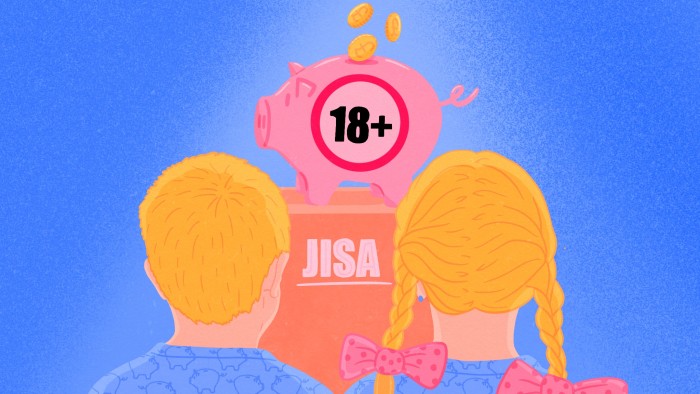Grandparents: give the gift of investment education


Roula Khalaf, Editor of the FT, selects her favourite stories in this weekly newsletter.
This article is the latest part of the FT’s Financial Literacy and Inclusion Campaign
Rising inheritance tax bills are certainly keeping the exchequer happy, but they’re also prompting more grandparents to think about tax planning while they are still alive.
Lots of readers are giving a lump sum to adult children or grandchildren — perhaps to help with a house purchase or pay down a slice of their mortgage. If you start the clock now, they won’t need to pay any IHT on the gift in seven years.
Funding grandchildren’s school fees is often seen as a wise investment — and good luck to readers who can afford that — but I’m focusing on the gift of financial education.
Our twin grandchildren (a girl and a boy) have just turned one. For their birthday present from now until they turn 18, my husband and I will fund a Junior Isa for each of them.
Having spent the past week looking into this, I hope this column will help fellow grandparents find the best option, for often it is we who fund and instigate these savings strategies. However, by law, only parents or guardians can actually open the tax-free investment accounts.
If you’re grappling with one bouncing baby, let alone two, comparing and contrasting the different Jisa options on the market is a mind boggling exercise. I’m not surprised that over the years, the majority of parents have plumped for cash Jisas.
The rates on these are getting better now (Coventry Building Society offers 4.7 per cent) but if you’re locking up this money for 18 years, stocks and shares should offer far superior returns.
Invest the full £9,000 Jisa allowance every year for 18 years, assuming an average 6 per cent annual return, and your child could be sitting on £280,000 by their late teens, calculates James Norton, head of financial planning at Vanguard. This factors in a 0.5 per cent all-in cost of investing; note the 2 per cent some discretionary managers charge would wipe £40,000 from the value of their pot.
We can’t afford to invest anywhere near that much, but we’ve committed to a regular monthly investment of £50 for each twin.
I like the flexibility of investing gradually rather than in one big lump — you never know what’s around the corner. As well as getting the benefit of pound cost averaging as the market rises and falls, it’s crystal clear for IHT purposes that this gift is coming from our surplus income, and thus will not be subject to any future tax clawback.
As you can see from the table below, most investment platforms set their minimum monthly Jisa subscription at £25 (note this is often per investment) but at Nutmeg and Vanguard, it’s higher at £100 per month.
Then there’s deciding what to invest in. I understand why the ready-made “click and go” investment choices offered by robo platforms such as Nutmeg, Money Farm, Wealthify and OneFamily are attractive for time-pressed parents, but the annual management charges will be more expensive.
However, the robo world definitely has the edge when it comes to tech. The apps are slick and it’s easy to share account details with grandparents, godparents, relatives and friends who might like to contribute at Christmas or birthdays instead of adding to the world’s plastic mountain.
Investment platforms where you pick your own funds or shares have lower fees. We don’t meet the £100 per month hurdle rate for Vanguard’s own platform, which has low annual management charges of 0.15 per cent. However, it’s currently possible to invest even more cheaply than this.
Hargreaves Lansdown and Fidelity have no annual management charges on Jisas. Nor does Interactive Investor, providing that one of the child’s parents is an existing customer. But fees and transaction charges will vary according to what you’re investing in (and how often).
Sticking with the low-cost theme, you probably won’t be surprised that I’ve earmarked a global equity tracker for the twins. Data from Hargreaves shows these are popular with Jisa customers, with Vanguard’s LifeStrategy range (these feature in my own stocks and shares Isa) plus Fidelity Index World and Legal & General’s International Index Trust ranking among the top picks.
It will be a bit of a faff opening two separate accounts for the twins with my stepdaughter, then getting the direct debit and regular investment plan set up for each. However, I’m confident it will be a smoother process than opening the government’s Tax Free Childcare Account, which she managed to do last month after a long and frustrating online battle. Dealing with a “poonami” is an easier task.
Next, I will turn my attention to the Jisas of my seven-year-old twin nephews. Since they were in nappies, Auntie Claer has invested £50 a month each into a global equity tracker on an investment platform. I can’t tell you exactly how well this has performed, as my brother and his brood are in Pembrokeshire, and the password for their account is in London.
In terms of platform fees, the cheapest option seven years ago is unlikely to be the cheapest now. When they’re back from holiday we will look into transferring to another provider (most of the investment Jisa providers will accept transfers in).
I’ll keep the bulk of their money in trackers, but I also want to introduce the boys to stage two of my Jisa plan — adding a few shares.
I got this idea from Lord John Lee, who recently popped in to the FT to record a Money Clinic investment masterclass podcast. His grandsons are not much older than my nephews and the shares in their mini-portfolio are brands they can identify with, such as Hollywood Bowl, Greggs and Sainsbury’s supermarket.
One day, the seven-year-old asked if he could buy shares in Standard Chartered bank. And no, he hadn’t been reading grandad’s copy of the FT — it turned out the bank sponsors Liverpool, his favourite football team.
I’d keep any “satellite shares” as a small percentage of their portfolio, but as they get older, there are so many teachable moments from numbers and percentages to what news events drive share prices up or down and the joy of compound interest. Understanding risk and dealing with losses are less pleasant lessons, but just as crucial.
“Plus, it will be all the more interesting to them because it’s their own money,” says Maike Currie, head of content and campaigns at Hargreaves, who intends to do exactly the same with her own daughters’ Jisas.
I reckon my nephews will be more attracted to US shares such as Amazon and Netflix, but this brings an added lesson — the impact of currency charges.
I’ve already made it clear to the boys they can take control of this money when they turn 18 when their accounts become adult stocks and shares Isas.
While they might want to spend some of it, I hope the gift of teaching them about investing will prove more valuable than the cash itself and they will keep up the regular savings habit.
Claer Barrett is the FT’s consumer editor and the author of ‘What They Don’t Teach You About Money’. claer.barrett@ft.com Instagram @Claerb



Comments